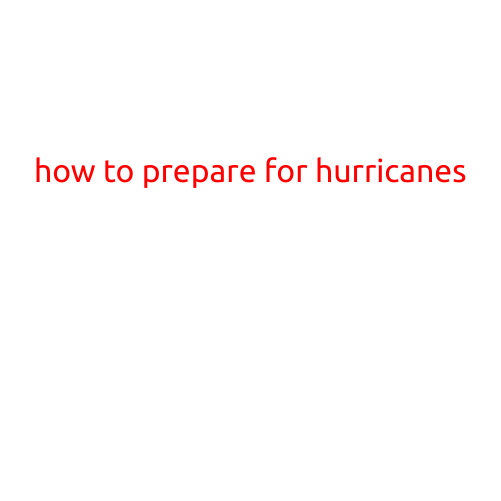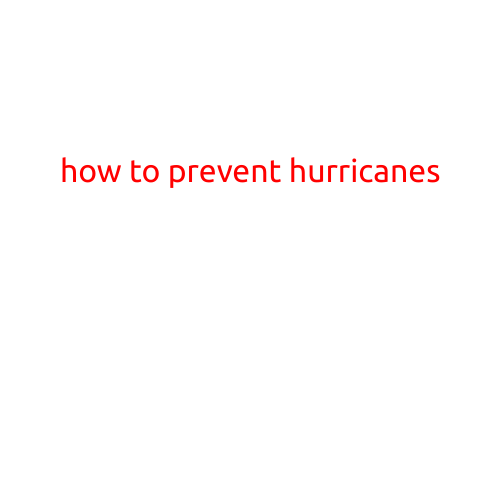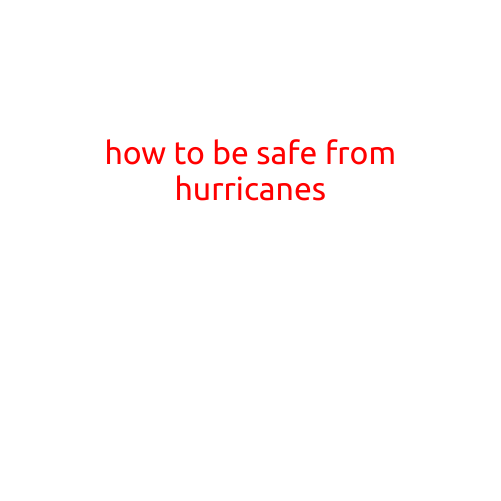
How to Prepare for Hurricanes: A Step-by-Step Guide
As hurricane season approaches, it’s essential to be prepared and take necessary precautions to ensure your safety and the safety of your loved ones. Hurricanes can bring strong winds, heavy rainfall, and storm surges that can cause damage to your home and disrupt daily life. By following these steps, you can minimize the impact of a hurricane and keep your family safe.
Step 1: Create a Disaster Plan
- Identify your emergency contact numbers and keep them easily accessible.
- Create a plan for evacuating, in case of a mandatory evacuation order.
- Designate a meeting point outside the home where family members can gather in case of separation.
- Plan for alternative communication methods in case phone service is disrupted.
Step 2: Stock an Emergency Kit
- Fill a waterproof container with essential items, such as:
- Water (at least 1 gallon per person per day)
- Non-perishable food and snacks
- Flashlights and extra batteries
- First aid kit
- Battery-powered radio and/or a NOAA Weather Radio
- Whistle to signal for help if needed
- Sanitation supplies (e.g. toilet paper, soap, etc.)
- Multi-tool or pocket knife
- Cash and credit cards
- Prescription medications and essential medical equipment
- Make sure to update your kit regularly to ensure all items are still usable.
Step 3: Prepare Your Home
- Trim or remove trees and shrubs to minimize damage from wind and debris.
- Install storm shutters or impact-resistant windows to protect windows from high winds and flying debris.
- Cover windows with plywood or acrylic sheets if storm shutters are not available.
- Clear your gutters and downspouts to ensure proper water drainage.
- Bring outdoor furniture, decorations, and other items inside or secure them to a solid surface.
- Disconnect electrical appliances and empty fuel from grills and generators.
Step 4: Stay Informed
- Monitor local news and weather reports for updates on the storm’s trajectory and forecasted impact.
- Register for emergency alerts from your local government or weather service.
- Download hurricane tracking apps to stay up-to-date on the storm’s progress.
Step 5: Prepare Your Vehicle
- Fill up your gas tank and make sure your vehicle is in good working condition.
- Keep a full tank of gas in your generator, if you have one.
- Make sure you have a full tank of gas for your vehicle, in case you need to evacuate.
- Bring a car charger for your phone and other devices.
Step 6: Plan for Alternative Sources of Power
- Consider purchasing a portable generator or installing a backup power system.
- Make sure you have a plan for alternative lighting, such as flashlights or battery-powered lanterns.
- Keep your refrigerator and freezer doors closed to maintain food safety.
Step 7: Prepare Your Pets
- Keep a pet emergency kit with essential items, such as food, water, and medication.
- Make sure your pet has a comfortable and safe place to ride out the storm.
- Consider evacuating your pets with you, if possible.
Step 8: Stay Safe During the Storm
- Stay indoors and away from windows during the storm.
- Avoid traveling and stay off the roads.
- Keep your phone charged and with you at all times.
- Follow evacuation orders and instructions from local authorities.
Step 9: Recovery and Cleanup
- Wait for the storm to pass and for it to be safe to exit your home.
- Take photos of any damage to your property for insurance purposes.
- Wear protective gear, such as gloves and a mask, when cleaning up debris and assessing damage.
- Be patient and prioritize your safety and well-being during the recovery process.
By following these steps, you can minimize the impact of a hurricane and keep your family safe. Remember, preparation is key, so take the time to prepare your home, yourself, and your loved ones for the potential arrival of a hurricane.





